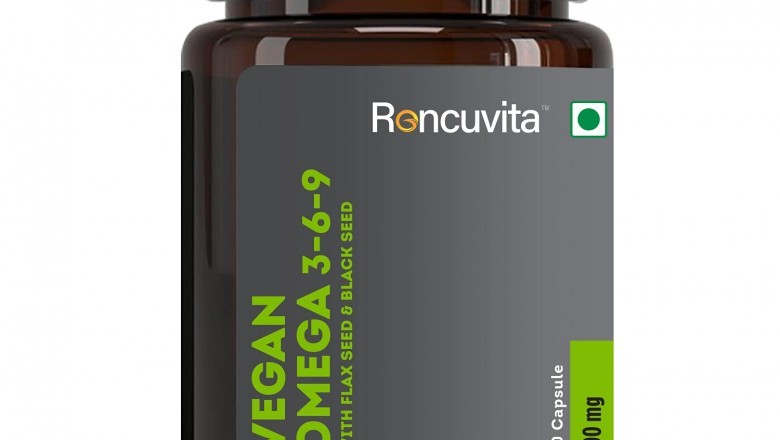views

Omega 3 and omega 6 are both essential fatty acids, meaningyour body needs them but cannot make them naturally. By contrast, omega 9 fattyacids aren’t essential because the body can make them. Each type has differentfunctions and benefits. Let’s take a closer look at these three unique fattyacids…
The Omega Connection: 3, 6 & 9
Omega-3 Fatty Acids
Omega 3 fattyacids are found in a high concentration in fish, olive oil, garlic, andwalnuts. Though these foods are common, most people don’t eat them in adequatequantities it would take to get beneficial levels. But also, the body is veryinefficient at converting plant omega-3s into the omega-3s the body needs,which are EPA and DHA.
Omega-3s are crucial for brain health. They are vital forour nerve cells and other brain cells to make and maintain the trillions ofconnections that our brain uses for information processing and for moving ourlimbs. Omega-3s are also vital for our brain cells – and all our cells – tomake the energy they need in order to function.
Omega-3s play a crucial role in the body’s healthy inflammatoryresponses, which reduce the chances of having problems with your circulation,joints, and other organs. Omega-3s are also essential for healthy hair andskin. Also, because of how important it is during an infant’s development,pregnant women are encouraged to take it in order to minimize any potential fortheir children to have problems with vision or brain health including learning,attention, and behavior.
When considering the immense benefits that omega 3 fish oilessential fatty acids have on the body, it’s easy to see why they arerecommended to nearly everybody for their preventative and wellness qualities.
EPA and DHA
EPA vs DHA Omega-3’s health benefits primarily come fromtheir long-chain fatty acids (EPA and DHA). In fact, DHA is the most prevalentfatty acid found in the brain. DHA fatty acid is vital to the creation andmaintenance of all the cells and the trillions of connections in both the brainand the retina (which functionally is an extension of the brain).
Omega-3 EPA fatty acid is less abundant than the omega-3 DHAfatty acid in the cells of the brain but is known to be essential for healthyinflammatory responses as well as for the production of new nerve cells. Forreasons still not fully understood, omega-3 fish oils that contain more EPAthan DHA are better at promoting healthy attention and behavior in childrenthan higher-DHA fish oils.
As the body ages, it seems to become less efficient at usingomega-3 EPA and DHA. But whether you’re young, middle-aged or getting on inyears, it’s important to have your Omega-3 Index measured. An index valuegreater than 8 percent suggests you have adequate omega-3 status. It’sincredibly important that anyone looking to stay on top of their mental gameincorporate omega-3s into their healthcare regimen and maintain their Omega-3Index between 8 and 12 percent.
Omega-6Fatty Acids
Omega-6 fatty acids are commonly found in today’s moderndiet because of their content in:
· Cereals
· Vegetableoil (soybean, sunflower, safflower, corn, canola)
· Fastfood items (such as French fries, popcorn chicken, onion rings)
· Dairyand eggs
· Allmeats
· Manybaked items (such as muffins, cookies, bread)
Modern research indicates that many people living on theWestern-type diet have too high a ratio of omega-6 compared to omega-3 fattyacids in their cells. There’s very little scientific evidence that having toomuch omega-6 compared to omega-3 in the diet is harmful to our overall healthand well-being. High intakes of omega-6s may increase tendency to less healthyinflammatory responses, which bring their own set of risks and have been linkedto mood problems.
The omega-6 fatty acids are essential for all our organfunctions, but the important takeaway here is that they need to be balanced inthe diet by adequate intakes of omega-3s and omega-9s.
Optimal Omega Levels
Only two fatty acids are absolutely proven essential forhumans: linoleic acid (LA), the parent fatty acid of the omega-6 series, andalpha-linolenic acid (ALA), the parent fatty acid of the omega-3 series. Havingoptimal omega-3 and omega-6 fatty acids is essential for health, andsupplementing with omega-3s to balance out the omega-6 to omega-3 ratio canensure many health benefits. But the body is very inefficient at making EPA andDHA from ALA, meaning that for all practical purposes, EPA and DHA areessential fatty acids: we have to get them in our diet.
Appropriate ratios are key. Eating too many foods rich inomega-6 fatty acids is a problem because they can cancel out the benefits ofomega-3 fatty acids when the ratio of omega 6 toomega-3 is too high. The optimal ratio is not known, except that we need atleast an Omega-3 Index of 8-12 percent. However, most Americans are running anindex under 8 percent, with an average index of 5.1!
Omega-3 EPA and DHA and certain omega-6 fatty acids areessential for our health, but the usual Standard American diet (SAD) gives ustoo little of the former and too much of the latter. The best way to balancethe ratio is to eat fewer foods that contain omega-6 fatty acids and more thatcontain omega-3 fatty acids. Unfortunately, because the body is so inefficientat converting plant ALA into EPA and DHA, we need to eat foods that containthese omega-3s performed, namely cold-water fish. Considering dollar costs,convenience, and the dangers of contamination of fish with mercury and hundredsof other environmental pollutions, many authoritative organizations recommendtaking reputable concentrated fish oil supplements.
RONCUVITA recommends a minimum of 1000 mg per day of EPA+DHAto ensure reaching an omega-3 index above 8 percent within a few months. Readthe supplement label carefully to find the EPA+DHA content, not the total fishoil content. Many budget fish oil supplements supply only 300 mg, not 1000 mgof EPA+DHA as their recommended daily dose.
Omega-9 Fatty Acids
Unlike omega-3 and omega-6 fatty acids, which arepolyunsaturated fats, omega-9 fatty acids are monounsaturated. Omega 9 fattyacids are essential for our cells to work but aren’t a dietary essential,because they can be produced by the body. Omega-9 fats are found in olive oil,some other plant oils, and some nuts and seeds.
Since people tend to consume more omega-6s than they mayneed, and the body produces omega-9s, there isn’t a great need to supplementwith either of these fatty acids. Unfortunately, most Americans are deficientin omega-3s, and there’s a huge body of studies that indicate a majority ofAmerican adults have suboptimal levels of EPA and DHA.
This underscores the need to take a quality omega-3 fish oilsupplement daily. RONCUVITA offers a potent, highly concentrated fish oilproduct in Omega-3 Power. Each serving of Omega-3 Power provides 1,440 mg ofEPA and DHA from ultra-purified, high-quality fish oil – roughly 5 times whatyou’d find in conventional brands and big box stores!
At RONCUVITA, we’re dedicated to providing the highestpurity nutrients to improve your brain and overall well-being. For moreinformation about Omega 3 6 9 andour full list of supplements, please visit us at RONCUVITA.COM












